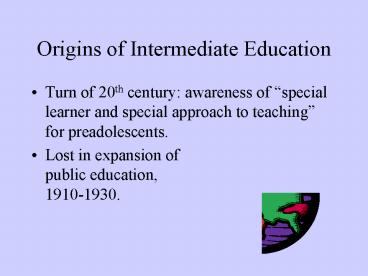Origins of Intermediate Education - PowerPoint PPT Presentation
1 / 24
Title:
Origins of Intermediate Education
Description:
Origins of Intermediate Education. Turn of 20th century: awareness of 'special ... Competence based on application as well as knowing. Room for ... Apperception ... – PowerPoint PPT presentation
Number of Views:35
Avg rating:3.0/5.0
Title: Origins of Intermediate Education
1
Origins of Intermediate Education
- Turn of 20th century awareness of special
learner and special approach to teaching for
preadolescents. - Lost in expansion of public education,
1910-1930.
2
Models of Education (US)
- Old Public Education
- Government program
- Literacy taught
- Foundational Knowledge
- Mass Production
- Behaviorism
- New set of ideas
- Humanistic (person-centered)
- Pestalozzi, Froebels, Darwin
- John Dewey
- Progressive Education
3
Deweys Model
- Child-centered
- School as community Climate of positivism
- Subject matter focusliving
- Integrated into everyday experiences
- Experience-based
- Competence based on application as well as
knowing - Room for differences and creativity
4
Deweys Conditions for Growth
- Freedom to investigate
- Choice in school experiences
- Ability to meet and solve problems that would be
confronted later in life - Development of a growing consciousness
5
Action Learning
- Students investigate, reflect, and develop
generalizations to guide future decision making - Roots in the direct and present experiences of
learners
6
Apperception
- Belief that new knowledge was perceived or
comprehended in terms of old or previously
experienced understandings.
7
History of Middle School Movement
- 1904G. Stanley Hall Study (4000 youth)
- Documented unique stage of development
(preadolescent) - 1909First Junior High
- Columbus, Ohio
- 1910-Berkely, Calif. Supt. introductory high
school - 1920over 400 schools (7-8-9)
- Mid-1950s6,500 junior high schools
8
1910-1965
- MythJunior High was simply miniature high
school - 1915-1920extensive literature on the junior high
- Focus was specialness of preadolescent learner
and need to individualize - Large growth (200,000 to 5 million) derailed
efforts (1890-1920)
9
1910-1965 continued
- Focus shifted from curriculum and philosophy to
buildings and books - By 1930smini high school
- Absence of teachers trained for preadolescents
- Secondary trained focused on subject matter
- Departmentalization reduced flexibility
10
1910-1965 Part Three
- Junior highs began to deal with problems of
current middle schools (discipline, motivation,
drop out rate) - High point of theoretical resurgence List of
six basic functions of the junior high by Gruhn
and Douglas
11
1910-1965, part four
- Resurgence faded
- Great Depression
- Second World War
- Recovery period
12
Failure of the Junior High
- The inclusion of the ninth grade in the junior
high organization kept the school from developing
a curriculum to truly serve the preadolescent.
The ninth graders were tied to the graduation
requirements established in the 1890s and
required to have fixed coursed with fixed time
requirements. Once 9th graders were scheduled,
little flexibility remained for 8th and 7th
graders.
13
Failure of the Junior High (2)
- 9th Graders no longer preadolescents.
- Junior Highs had to meet 2 different
developmental stages.
14
The Early Middle School1965-2000
- Dr. William Alexander (official credit)
- Also John Lounsbury, Gordon Vars, and William Van
Til - Movement to reestablish a school for
preadolescents - Alexander revived term middle school, added a set
of educational attributes
15
The Early Middle School1965-2000
- Progressive school of thought
- Jr. Highsubject centered vs. Middle
Schoolstudent centered - 6-7-8 rather than 7-8-9
- Extend to 5-6-7-8
- Common factor experiencing puberty
16
Facilitators of Middle Level Reform
- Sputnik (general unhappiness with education)
- Brown v. Topeka (desegregation)
- Increased enrollment (after WW II)
- Readiness for change
17
Alexanders Proposal
- Followed original literature of the junior highs
broad-based general education, with 3 key
points - Education for social competence
- Mastery of basic learning skills
- Personal Development
- Exploration, not mastery
- Bridge
18
Middle School Movement
- Longest running curriculum innovation
- Early mistake de-emphasis of child-centeredness
of the curriculum emphasis on grade level
change. - Results
- Focus on organizational change
- Ill-defined curriculum
- No clear learning theory
19
Early Middle Schools
- Block Scheduling
- Common Planning Periods
- Advisory Guidance
- Interdisciplinary Instruction
- Development of programs
- Focus on programs, not curriculum
20
Failures of Middle School
- Vision versus reality
- Junior High sidetracked by growth but
- Middle School sidetracked by lack of vision
- Not translated into schools
21
1965-2000
- Instructional Innovations
- Integration
- Public Law 94-142 (mainstreaming)
- IDEA Act (inclusion)
22
Middle School Promise
- Early promises were strong on philosophy and weak
on details. - Advocated a unique school, not a jr. high nor a
elementary extension
23
Promise vs. Reality
- Meet unique needs of students
- Balanced curriculum of knowledge, skills, and
personal development - Exploration
- Caring and Accepting climate
- Personal Guidance to Each Student
- Grouping by ability and serving by labels
- Back to BasicsTesting and Accountability
- Lack of individual exploration for all.
- Star system
- One counselor per 400 students
24
Middle Schools did not fully meet these goals
- School designed for preadolescent learner
- School that would serve each learner as an
individual - School with a comprehensive, balanced learning
program - School that would allow the learner to explore
and understand him/herself - School with a caring and accepting climate
- School providing a personal guidance program































